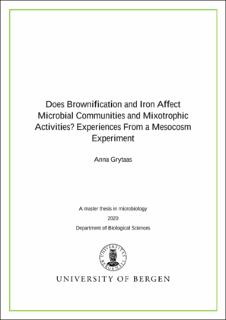| dc.description.abstract | In one millilitre of seawater there is on average approximately a million microbial cells, and these are largely responsible for nearly half of all primary production on Earth. Mixotrophic microorganisms are ubiquitous in the photic zone of the ocean yet their role has long been unclear. Marine mixotrophs are, as all marine organisms, expected to be affected by the current climate changes. Increased temperatures are expected to increase brownification of lakes and coastal waters due to more precipitation causing higher input of dissolved organic carbon (DOC). The darker water is in turn hypothesised to increase phagotrophy in mixotrophs due to lower availability of light, which is needed to perform photosynthesis. Increased availability of dissolved iron (dFe) has been observed in relation to increased input of DOC. My main hypotheses were that brownification and increased dFe concentrations lead to changes in the microbial community composition, that brownification promotes higher percentages of mixotrophic plankton, and that altered dFe concentrations affect these percentages. To test these hypotheses, samples from a mesocosm experiment were examined through flow cytometry by enumerating different groups and species and, using the probe LysoTracker, investigating how many phototrophs performed phagotrophy. Here I show that brownification did change the composition of the microbial community but did not lead to higher percentages of mixotrophic organisms. Addition of dFe did not affect composition nor mixotrophic percentages. Among the groups accounted for in this experiment, brownification led to increased abundances of autotrophic picoeukaryotes and bacteria, and decreased abundances of autotrophic nanoeukaryotes (ANEs). Brownification also led to decreased percentages of mixotrophic ANE cells. Though addition of dFe was expected to induce a bloom of the coccolithophore Emiliania huxleyi, no effect was observed in any of the studied groups. Some ANEs were pictured through confocal microscopy and shown to have unspecific staining from LysoTracker. The factors controlling mixotrophy in microbial communities, especially in relation to climate change, are yet to be understood. As this and similar studies show, a change in the microbial communities is expected to happen due to ongoing climate change. Understanding these effects is important to understand how whole marine communities will change. This is just one of many new studies in this study area, and there is much yet to explore before a clearer understanding of what will happen is reached. | |
